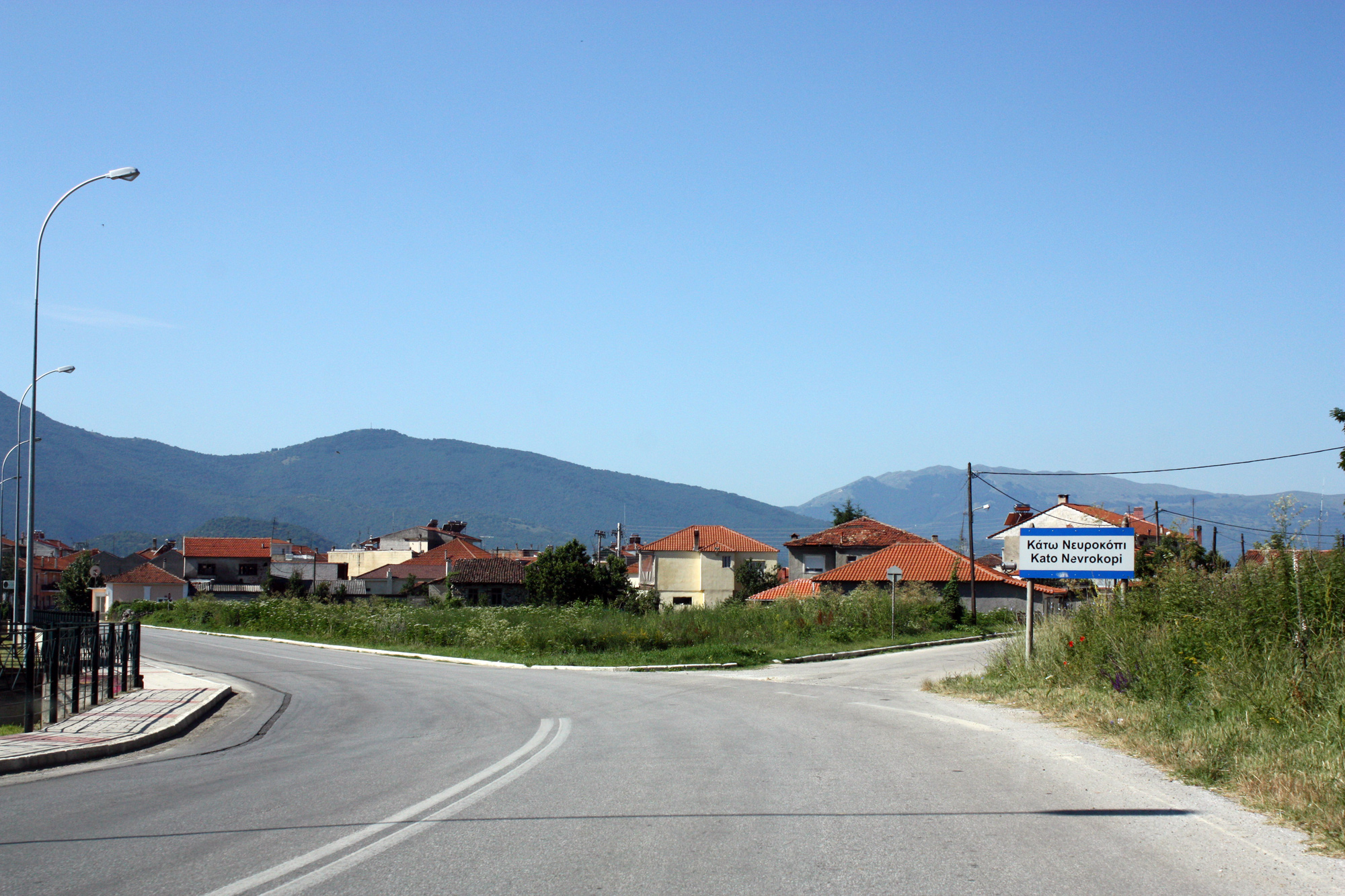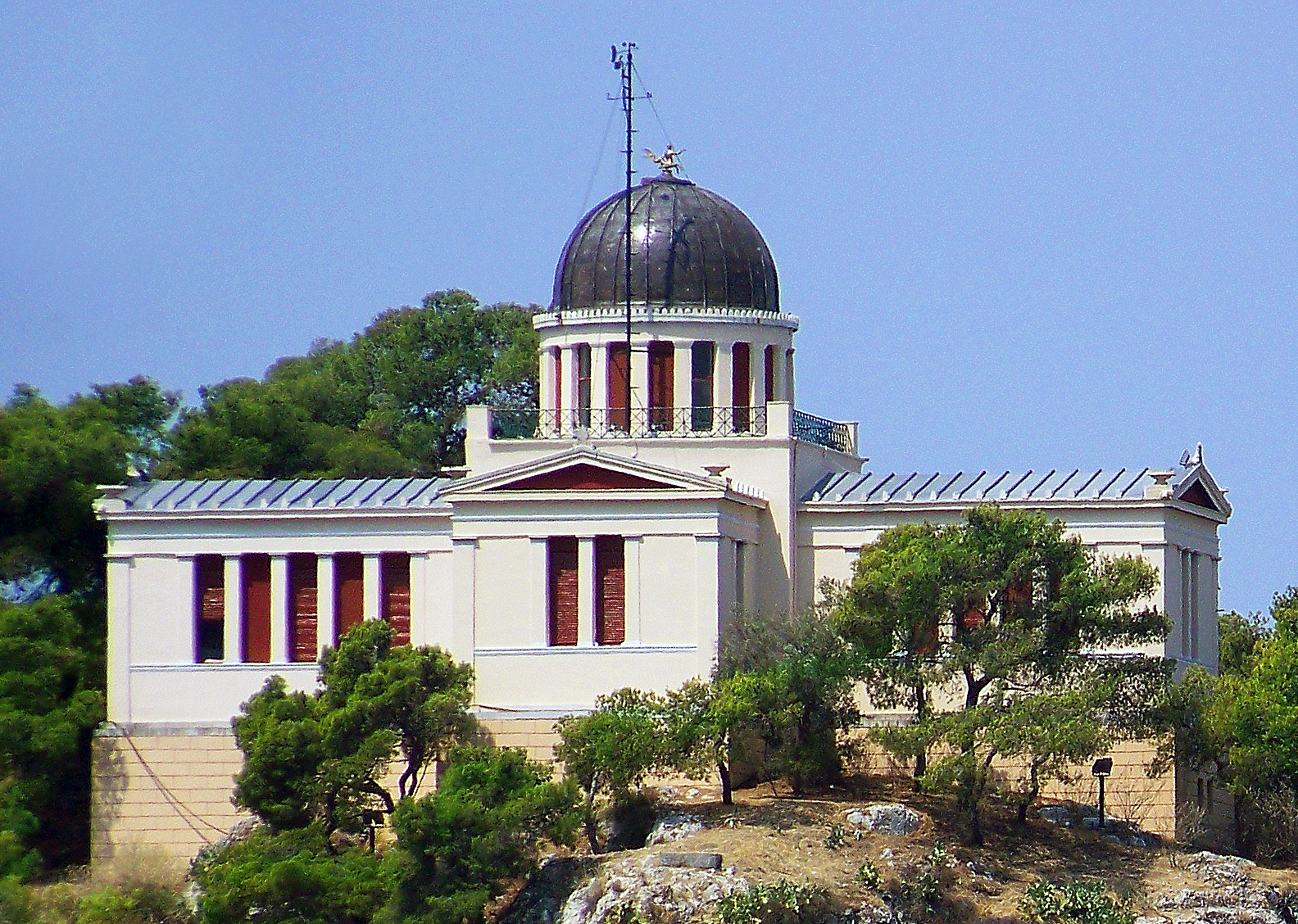|
Kato Nevrokopi
Kato Nevrokopi ( el, Κάτω Νευροκόπι "Lower Nevrokopi") is a municipality and town within that municipality in the northwest section of the Drama regional unit, Greece. Before the 2011 local government reform, it was the largest municipality in all of Greece, covering an area of 873.552 km2 (337.28 sq mi). The 2011 census reported a population of 7,860 inhabitants. The region is known for the very low temperatures during the winter and for its famous agricultural products such as potatoes and beans. The area has several features to attract tourists: the ski center of Falakro, the traditional settlement in the village of Granitis (pop. 78), the historical bunker of Lise, the artificial lakes of Lefkogeia and Potamoí, the spectacular routes in the forests, the old churches. The forest paths offer excellent views to hikers. The largest towns are Kato Nevrokopi (the municipal seat, pop. 2,157), Volakas (1,028), Perithorio (898), Lefkogeia (465), Kato Vrontou ... [...More Info...] [...Related Items...] OR: [Wikipedia] [Google] [Baidu] |
East Macedonia And Thrace
Eastern Macedonia and Thrace ( el, Ανατολική Μακεδονία και Θράκη, translit=Anatolikí Makedonía ke Thráki, ) is one of the thirteen administrative regions of Greece. It consists of the northeastern parts of the country, comprising the eastern part of the region of Macedonia along with the region of Western Thrace, and the islands of Thasos and Samothrace. Administration Administrative history The region of Eastern Macedonia and Thrace was established in the 1987 administrative reform as the Eastern Macedonia and Thrace Region ( el, Περιφέρεια Ανατολικής Μακεδονίας και Θράκης, translit=Periféria Anatolikís Makedhonías ke Thrákis. With the 2010 Kallikratis plan, its powers and authority were redefined and extended, with the preexisting region in many respects inheriting status and weight of the five now abolished prefectures, Drama, Evros, Kavala, Rhodope and Xanthi. In this special case, the region of Eas ... [...More Info...] [...Related Items...] OR: [Wikipedia] [Google] [Baidu] |
Vlachs
"Vlach" ( or ), also "Wallachian" (and many other variants), is a historical term and exonym used from the Middle Ages until the Modern Era to designate mainly Romanians but also Aromanians, Megleno-Romanians, Istro-Romanians and other Eastern Romance-speaking subgroups of Central and Eastern Europe. As a contemporary term, in the English language, the Vlachs are the Balkan Romance-speaking peoples who live south of the Danube in what are now southern Albania, Bulgaria, northern Greece, North Macedonia, and eastern Serbia as native ethnic groups, such as the Aromanians, Megleno-Romanians and the Timok Romanians. The term also became a synonym in the Balkans for the social category of shepherds, and was also used for non-Romance-speaking peoples, in recent times in the western Balkans derogatively. The term is also used to refer to the ethnographic group of Moravian Vlachs who speak a Slavic language but originate from Romanians. "Vlachs" were initially identified and des ... [...More Info...] [...Related Items...] OR: [Wikipedia] [Google] [Baidu] |
Municipalities Of Eastern Macedonia And Thrace
A municipality is usually a single administrative division having corporate status and powers of self-government or jurisdiction as granted by national and regional laws to which it is subordinate. The term ''municipality'' may also mean the governing body of a given municipality. A municipality is a general-purpose administrative subdivision, as opposed to a special-purpose district. The term is derived from French and Latin . The English word ''municipality'' derives from the Latin social contract (derived from a word meaning "duty holders"), referring to the Latin communities that supplied Rome with troops in exchange for their own incorporation into the Roman state (granting Roman citizenship to the inhabitants) while permitting the communities to retain their own local governments (a limited autonomy). A municipality can be any political jurisdiction, from a sovereign state such as the Principality of Monaco, to a small village such as West Hampton Dunes, New York. The ... [...More Info...] [...Related Items...] OR: [Wikipedia] [Google] [Baidu] |
Theodosius Of Skopje
Theodosius of Skopje ( bg, Теодосий Скопски, mk, Теодосиј Гологанов; 1846–1926) was a Bulgarian religious figure from Macedonia who was also a scholar and translator of the Bulgarian language. He was initially involved in the struggle for an autonomous Bulgarian Church and later in his life, he became a member of the Bulgarian Academy of Sciences. Although he was named Metropolitan Bishop of the Bulgarian Exarchate in Skopje, he is known for his failed attempt to establish a separate Macedonian Church as a restoration of the Archbishopric of Ohrid. Theodosius of Skopje is considered a Bulgarian in Bulgaria and an ethnic Macedonian in North Macedonia. Biography Theodosius of Skopje was born as Vasil Iliev Gologanov (Bulgarian & Macedonian: Васил Илиев Гологанов) in the then Slavic populated village of Tarlis (now part of Kato Nevrokopi, Greece) in the Ottoman Empire. His brother Ivan Gologanov was a collector of folk son ... [...More Info...] [...Related Items...] OR: [Wikipedia] [Google] [Baidu] |
Armen Kouptsios
Armen Kouptsios ( el, Άρμεν Κούπτσιος, Bulgarian Армен Купциос, 1885 - 1906) was a Macedonian Greek revolutionist. Life Kouptsios was born in Volakas in what was then the Ottoman Empire in 1885. He met the Greek Makedonomachos Capitan Dais, who was at that time a teacher in Prosotsani. Captain Dais organized the Macedonian Struggle in Drama. Kouptsios told Dais that he was willing to sacrifice his life for Greece. The Archdeacon of Bishop of Drama, Chrysostomos, Themistoklis Chatzistavrou (known as Archbishop of Athens and in Greece, Chrysostomos II), in the ''Macedonian Diary'' of 1965, writes, "The organization that was initiated by the Greeks was completely secret. We were trying to keep Bishop Chrysostomos away from the danger. We wanted to protect him from the danger that his surging character and his fiery patriotism were leading him. Ion Dragoumis was the general leader of the organization. I was in charge to adjure the initiated members in D ... [...More Info...] [...Related Items...] OR: [Wikipedia] [Google] [Baidu] |
National Observatory Of Athens
The National Observatory of Athens (NOA; el, Εθνικό Αστεροσκοπείο Αθηνών) is a research institute in Athens, Greece. Founded in 1842, it is the oldest research foundation in Greece, as it was the first scientific research institute built after Greece became independent in 1829, and one of the oldest research institutes in Southern Europe. World-renowned Greek-Austrian astronomer Georgios Konstantinos Vouris lobbied to create the National Observatory of Athens in the newly founded state. He persuaded wealthy Greek-Austrian banker Georgios Sinas to pay for the new massive observatory. The Austrian-born Greek King found out the news and awarded Georgios Sinas's son the Order of the Redeemer. The King also selected the architects for the building under Georgios Konstantinos Vouris's supervision. He chose Eduard Schaubert and Theophil Hansen. History 1842: Foundation Greek-Austrian astronomer Georgios Konstantinos Vouris studied astronomy at the V ... [...More Info...] [...Related Items...] OR: [Wikipedia] [Google] [Baidu] |
Hot-summer Mediterranean Climate
A Mediterranean climate (also called a dry summer temperate climate ''Cs'') is a temperate climate sub-type, generally characterized by warm, dry summers and mild, fairly wet winters; these weather conditions are typically experienced in the majority of Mediterranean-climate regions and countries, but remain highly dependent on proximity to the ocean, altitude and geographical location. This climate type's name is in reference to the coastal regions of the Mediterranean Sea within the Mediterranean Basin, where this climate type is most prevalent. The "original" Mediterranean zone is a massive area, its western region beginning with the Iberian Peninsula in southwestern Europe and coastal regions of northern Morocco, extending eastwards across southern Europe, the Balkans, and coastal Northern Africa, before reaching a dead-end at the Levant region's coastline. Mediterranean climate zones are typically located along the western coasts of landmasses, between roughly 30 and 4 ... [...More Info...] [...Related Items...] OR: [Wikipedia] [Google] [Baidu] |
Humid Continental Climate
A humid continental climate is a climatic region defined by Russo-German climatologist Wladimir Köppen in 1900, typified by four distinct seasons and large seasonal temperature differences, with warm to hot (and often humid) summers and freezing cold (sometimes severely cold in the northern areas) winters. Precipitation is usually distributed throughout the year but often do have dry seasons. The definition of this climate regarding temperature is as follows: the mean temperature of the coldest month must be below or depending on the isotherm, and there must be at least four months whose mean temperatures are at or above . In addition, the location in question must not be semi-arid or arid. The cooler ''Dfb'', ''Dwb'', and ''Dsb'' subtypes are also known as hemiboreal climates. Humid continental climates are generally found between latitudes 30° N and 60° N, within the central and northeastern portions of North America, Europe, and Asia. They are rare and isolat ... [...More Info...] [...Related Items...] OR: [Wikipedia] [Google] [Baidu] |
North Macedonia
North Macedonia, ; sq, Maqedonia e Veriut, (Macedonia before February 2019), officially the Republic of North Macedonia,, is a country in Southeast Europe. It gained independence in 1991 as one of the successor states of Socialist Federal Republic of Yugoslavia, Yugoslavia. It is a landlocked country bordering Kosovo to the northwest, Serbia to the north, Bulgaria to the east, Greece to the south, and Albania to the west. It constitutes approximately the northern third of the larger geographical Macedonia (region), region of Macedonia. Skopje, the capital and largest city, is home to a quarter of the country's 1.83 million people. The majority of the residents are ethnic Macedonians (ethnic group), Macedonians, a South Slavs, South Slavic people. Albanians in North Macedonia, Albanians form a significant minority at around 25%, followed by Turks in North Macedonia, Turks, Romani people in North Macedonia, Romani, Serbs in North Macedonia, Serbs, Bosniaks in North Mac ... [...More Info...] [...Related Items...] OR: [Wikipedia] [Google] [Baidu] |
Štip
Štip ( mk, Штип ) is the largest urban agglomeration in the eastern part of North Macedonia, serving as the economic, industrial, entertainment and educational focal point for the surrounding municipalities. As of the 2002 census, the city of Štip had a population of about 43,652.Macedonian Census (2002) ''Book 5 - Total population according to the Ethnic Affiliation, Mother Tongue and Religion'' The State Statistical Office, Skopje, 2002, p. 196. Štip is the largest textile production center in the country. It is the center of the fashion industry in North Macedonia, as well as the site of the sole public university in eastern North Macedonia, Goce Delčev University of Štip. The city of Štip is the seat of Štip Municipality. Name The name Astibos is mentioned first by the ancient historian Polyaenus in 2nd century BC, who notes that Paeonian kings did ritualistic bathing in the Astibo / Brigantium (today: Bregalnica) river, as a coronation ritual. Astibo is also mar ... [...More Info...] [...Related Items...] OR: [Wikipedia] [Google] [Baidu] |
Slavic Macedonian
Macedonians ( mk, Македонци, Makedonci) are a nation and a South Slavic ethnic group native to the region of Macedonia in Southeast Europe. They speak Macedonian, a South Slavic language. The large majority of Macedonians identify as Eastern Orthodox Christians, who speak a South Slavic language, and share a cultural and historical "Orthodox Byzantine–Slavic heritage" with their neighbours. About two-thirds of all ethnic Macedonians live in North Macedonia and there are also communities in a number of other countries. The concept of a Macedonian ethnicity, distinct from their Orthodox Balkan neighbours, is seen to be a comparatively newly emergent one. The earliest manifestations of an incipient Macedonian identity emerged during the second half of the 19th century among limited circles of Slavic-speaking intellectuals, predominantly outside the region of Macedonia. They arose after the First World War and especially during 1930s, and thus were consolidated by ... [...More Info...] [...Related Items...] OR: [Wikipedia] [Google] [Baidu] |




